Erosion, marine debris and other factors can harm and degrade our natural Galveston Bay habitat. By prioritizing programs that restore and protect our shorelines, remove potentially toxic substances from our waters, and reintroduce lost habitats, we’re able to work with you to ensure that Galveston Bay remains a healthy and productive place for generations to come.
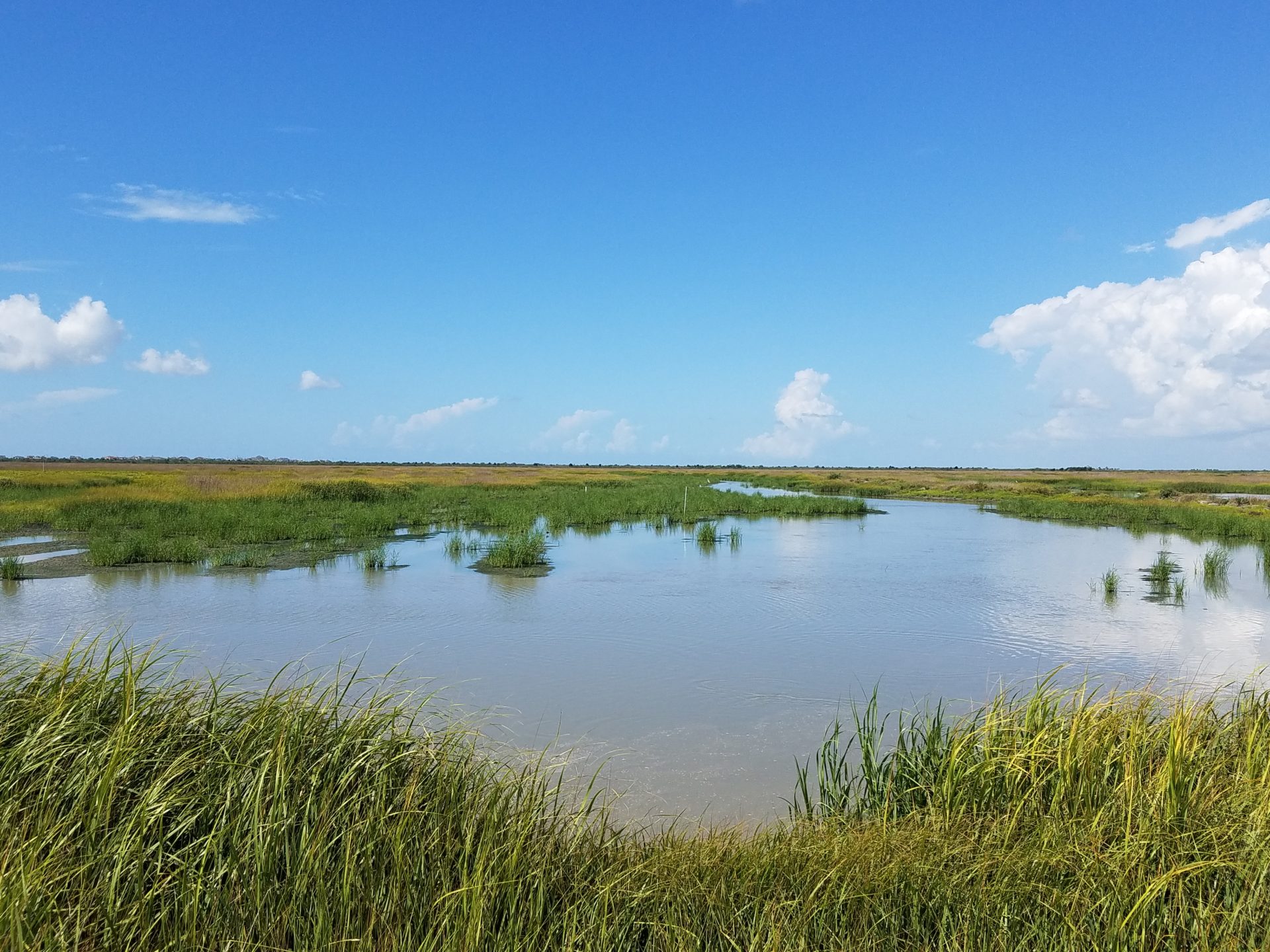
The Galveston Bay system has lost 8,000+ acres of saltwater wetlands and 80,000+ acres of freshwater wetlands in the past 20 years. Habitat degradation has been identified as the most critical of all the problems currently facing Galveston Bay in the Galveston Bay Plan.
In Texas, Coastal Wetlands:
-Provide nursery habitat for over 90% of the recreational and commercial fish species found in the Gulf of Mexico
-Provide natural filtration for polluted runoff
-Buffer for tides and storm surges, storing water during heavy rainfall events reduce shoreline erosion
The disappearance of wetlands from a large portion of Galveston Bay means that our area is more vulnerable to flooding and water quality issues. To date, Galveston Bay Foundation has restored over 990 acres of this vital coastal habitat.
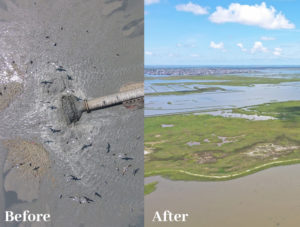 Featured Project: Pierce Marsh
Featured Project: Pierce Marsh Featured Project: Burnet Bay
Featured Project: Burnet Bay
Back in 1944, Burnet Bay was bounded by rather extensive wetlands. However, by 1995, the area experienced 5-8 feet of elevation loss due to subsidence which caused the wetlands to disappear along with native vegetation and wildlife. Through this project, we restored 33 acres of intertidal marsh complex by using dredge material to raise elevations and support the regrowth of wetland vegetation. Over 100 incredible community and corporate volunteers came together to transplant wetland vegetation into the newly established habitat.
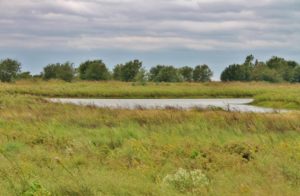 Featured Project: Rich Sanctuary
Featured Project: Rich Sanctuary
Rich Sanctuary is a 192-acre preserve in Chambers County adjacent to Trinity Bay. Galveston Bay Foundation partnered with the Natural Resource Conservation Service’s Wetland Reserve Program to restore the abandoned agricultural land into a functional wetland/prairie system by excavating shallow, isolated wetlands and planting native coastal prairie grasses. Long-term management goals for this property are to enhance mottled duck nesting habitat, promote high-quality habitat for migratory waterfowl and shorebirds, and increase the diversity within the coastal prairie plant community.

Did you know one oyster filters 50 gallons of water a day helping to remove unwanted pollutants? However, oysters and their habitat are threatened by increasingly powerful storms (60% of oyster habitat was lost in Hurricane Ike), overharvesting and pollution.
Unlike most sea creatures, oysters don’t just live in the water – they specifically need to live on other oyster shells. That is why Galveston Bay Foundation’s Oyster Shell Recycling Program is so important. It focuses on increasing the population of Eastern oysters by returning shucked oyster shells collected from local restaurants back to Galveston Bay to create new oyster habitat and a healthier Bay for all.
The resulting oyster reef also serves as shelter for crabs, shrimp, and juvenile fish, which in turn serve as a food source for other wildlife. In addition, the oyster reefs help stabilize sediment on the Bay bottom and can prevent erosion along shorelines. To date, we have recycled over 1,000 tons of oyster shells!
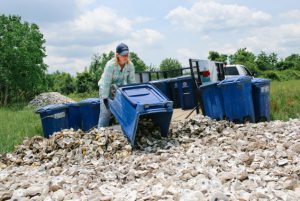 From Restaurants to Reefs:
From Restaurants to Reefs:
Creating a healthier Bay for all
Typically, restaurants send all the shells from shucked oysters to a landfill along with the rest of the restaurant’s trash. However, when shucked shells are returned to the water, they create a future habitat for oysters. Through our Oyster Shell Recycling Program, we partner with multiple Houston and Galveston area restaurants to collect shucked oyster shells and return them to the Bay to create oyster habitat.
View our full list of restaurant partners that recycle their shucked oyster shells with us!
View Our Current Restaurant Partners
For more information, please contact Shannon Batte at sbatte@galvbay.org or 832-536-2265.
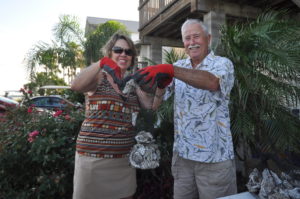 It might sound strange, but oysters can be gardened! We work with bayfront property owners interested in becoming oyster gardeners (or oyster foster parents, if you prefer) to improve the health of Galveston Bay. Every spring, Galveston Bay Foundation staff train volunteers in each participating community to create and maintain oyster gardens using recycled oyster shells. In May and June, each volunteer suspends their oyster gardens in the water below their dock or pier then monitors the gardens for fouling, predators, and (hopefully) the growth of baby oysters—or “spat”—on the shells. By fall, those spat will grow up to one inch or more, at which point they’re ready to be transplanted onto nearby restoration reefs and continue their important water filtration work.
It might sound strange, but oysters can be gardened! We work with bayfront property owners interested in becoming oyster gardeners (or oyster foster parents, if you prefer) to improve the health of Galveston Bay. Every spring, Galveston Bay Foundation staff train volunteers in each participating community to create and maintain oyster gardens using recycled oyster shells. In May and June, each volunteer suspends their oyster gardens in the water below their dock or pier then monitors the gardens for fouling, predators, and (hopefully) the growth of baby oysters—or “spat”—on the shells. By fall, those spat will grow up to one inch or more, at which point they’re ready to be transplanted onto nearby restoration reefs and continue their important water filtration work.
For more information, please contact Shannon Batte at sbatte@galvbay.org or 832-536-2265.
Please note that all of the oysters produced through our oyster gardening efforts are strictly for restoration purposes and are NOT for consumption.
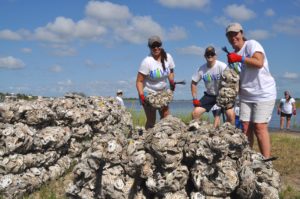 We work with volunteers to build linear oyster reefs, also known as oyster shell breakwaters, along eroding shorelines to create habitat and stabilize the shore. An oyster shell breakwater is created by placing mesh bags filled with recycled oyster shells parallel to the shoreline in a pyramid formation. The oyster shell breakwater not only provides new homes (the recycled shells) for baby oysters, it also protects the shoreline from wave action and thus reduces erosion. In addition, sediment will slowly build up behind the oyster shell breakwater, creating a protected habitat for marsh grass to flourish.
We work with volunteers to build linear oyster reefs, also known as oyster shell breakwaters, along eroding shorelines to create habitat and stabilize the shore. An oyster shell breakwater is created by placing mesh bags filled with recycled oyster shells parallel to the shoreline in a pyramid formation. The oyster shell breakwater not only provides new homes (the recycled shells) for baby oysters, it also protects the shoreline from wave action and thus reduces erosion. In addition, sediment will slowly build up behind the oyster shell breakwater, creating a protected habitat for marsh grass to flourish.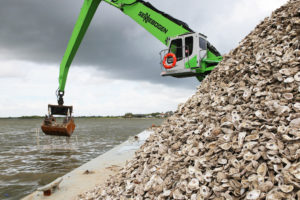 For larger-scale oyster reef restoration, we work with partners to place cultch material, such as river rock, limestone, or concrete rip-rap, on the Bay bottom and often place recycled oyster shells on top to provide the ideal habitat for native Bay oysters. These projects are typically constructed in deeper water and require the involvement of contractors to place the cultch, including shell, in large quantities, sometimes upwards of hundreds of tons in a single day. All of this material will then serve as homes for baby oysters.
For larger-scale oyster reef restoration, we work with partners to place cultch material, such as river rock, limestone, or concrete rip-rap, on the Bay bottom and often place recycled oyster shells on top to provide the ideal habitat for native Bay oysters. These projects are typically constructed in deeper water and require the involvement of contractors to place the cultch, including shell, in large quantities, sometimes upwards of hundreds of tons in a single day. All of this material will then serve as homes for baby oysters.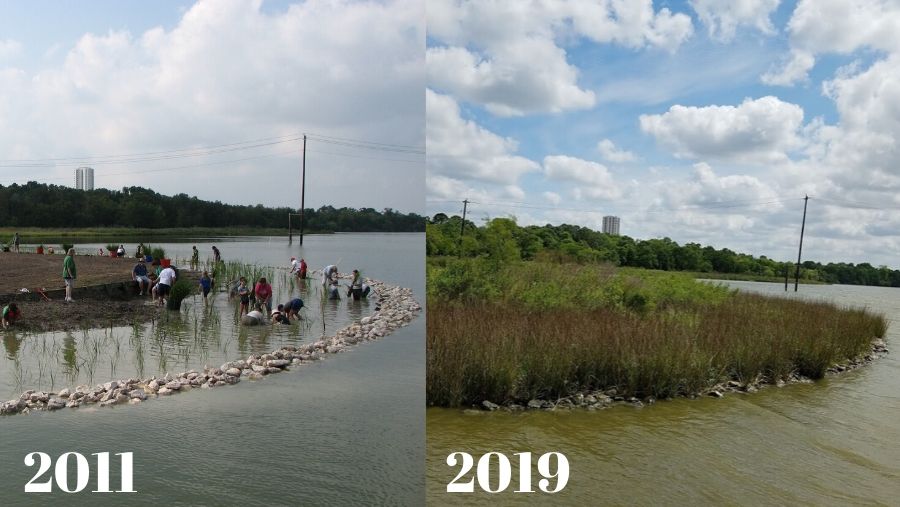
For Galveston Bay landowners who are concerned about erosion, we encourage the use of “living shorelines” to provide erosion control benefits while enhancing natural habitat. Through the strategic placement of natural materials such as plants, rock, or oyster shells, living shorelines reduce wave energy and erosion while supporting plant growth, marsh creation and improving water quality.
To date, Galveston Bay Foundation has protected over 22 miles of shoreline and restored nearly 52 acres of salt marsh through living shorelines.
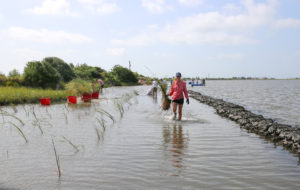 Sweetwater Lake
Sweetwater Lake
The Galveston Bay Foundation’s Sweetwater Nature Preserve is a 449-acre preserve located on Galveston Island. Over the last 10 years, the Sweetwater Lake shoreline has eroded at a rate of 1-2 feet per year. In order to protect the shoreline from further erosion, enhance native oyster populations, and restore salt marsh, we are working with volunteers to construct up to 1,900 linear feet of an oyster shell breakwater. The breakwater is being created with recycled oyster shell sourced from our Oyster Shell Recycling Program.
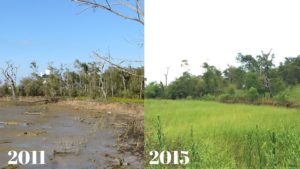 Shipe Woods
Shipe Woods
Shipe Woods is a 14.26-acre property located on the eastern shoreline of Trinity Bay that Galveston Bay Foundation acquired as a conservation property in 1991. As a result of severe wave energy and subsidence, over 100 feet of shoreline was lost in 10 years. To curb this erosion and prevent further habitat loss, Galveston Bay Foundation constructed a 725-foot rock breakwater in 2013. Volunteers helped plant smooth cordgrass near the shoreline which has now spread throughout the protected area behind the breakwater.

A common response to erosion control is to install a bulkhead. Unfortunately, bulkheads can increase erosion on adjacent, unprotected shorelines and are prone to structural failure over time. Along with our partners, Galveston Bay Foundation offers property owners assistance in creating individually designed living shoreline structures for your unique situation and property.
For more detailed information about living shorelines or the services we provide, contact Haille Leija at hleija@galvbay.org.

Coastal tallgrass prairies historically dominated the landscape on the upper Texas coast. Most of the Houston-Galveston region we call home was once a vast and diverse grassland system that cleaned the water coming into Galveston Bay and supported hundreds of plant and animal species. Unfortunately, less than 1% of those native prairies remain in a high-quality, functional condition. Our goal is to work diligently to locate, protect, and manage the exiting coastal prairie habitats within the Galveston Bay Watershed and restore native grasslands within our coastal preserves.
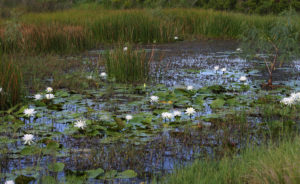 Gordy Marsh
Gordy Marsh
Galveston Bay Foundation’s Gordy Marsh conservation easement includes 1,739 acres of coastal wetland and prairie habitats near Smith Point in Chambers County. The property contains significant acreage of native coastal prairie that provides nesting habitat for many regionally important bird species such as bobwhite quail and mottled ducks.
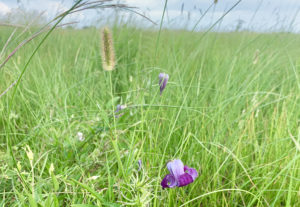 Angleton Prairie
Angleton Prairie
Galveston Bay Foundation owns 35 acres of coastal tallgrass prairie in Brazoria County, east of Angleton. This high-quality prairie supports a rich natural plant community and has a low proportion of non-native or invasive species. Coastal prairie habitat in this condition is considered to be globally rare and critically imperiled.
